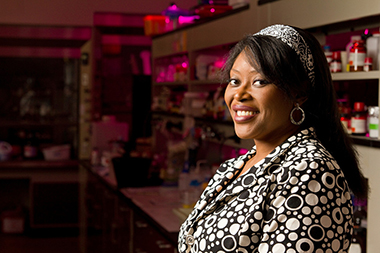Chemist Uses Blow Fly Eggs as Forensics Tool
 |
|
Rabi Musah, associate professor of chemistry.
(Photo by Paul Miller)
|
ALBANY, N.Y. (July 10, 2017) – Death investigators may soon be able to rely on tiny insect eggs to rapidly estimate a corpse’s time-of-death.
Blow flies are typically the first carrion insects to arrive and lay their eggs on a dead body. For forensic entomologists, determining the arrival order and growth rate of different species of blow fly eggs found on a corpse can help establish the body’s time-of-death to within a few hours.
The issue? Blow fly eggs are microscopic and not easy to differentiate. It can take days, or even several weeks, for experts to accurately classify them. In fact, it is still common practice to take eggs from a corpse and grow them to adults just to identify the species.
University at Albany organic chemist Rabi Musah wants to make the process easier.
She’s teamed up with forensic entomologist Jennifer Rosati of John Jay College and UAlbany graduate researcher Justine Giffen to develop a three-minute chemical analysis. It relies on mass spectrometry – the determination of masses of molecules within a sample – to rapidly classify blow fly eggs by species based on differences in their amino acid profiles.
Their findings were published this month in Analytical Chemistry and featured by Chemical & Engineering News.
“Our analysis is the first demonstration of a rapid chemical fingerprint-based method for blow fly species identification from eggs,” Musah said. “Differentiating insect eggs on corpses is of great forensic importance. Each species has its own development timeline, and therefore species identification of entomological evidence such as eggs can allow estimation of how long a body has been dead.”
The researchers used six pork liver traps placed around the Manhattan area to capture various blow fly species including members of the Calliphoridae, Phoridae and Sarcophagidae families, just before they laid eggs.
In a laboratory, trapped blow flies were identified by species and then given fresh liver on which to lay their eggs. Analysis of the eggs, through mass spectrometry, revealed differences in free amino acids between the species. The analysis required minimal sample preparation and results were obtained within a few minutes.
Musah and Rosetti are now testing the usefulness of their method in an active death investigation.
“We want to make the process of insect egg profiling much easier, quicker and cheaper for investigators,” Musah said. “Our approach circumvents many of the shortcomings of traditional analysis methods. No sample preparation steps or specialized expertise is required. The eggs can be analyzed right away, in the form in which they are collected at a crime scene.”
Musah, who grew up in Ghana, joined UAlbany’s Department of Chemistry in 1998. Her research in small-molecule mass spectrometry impacts several specific areas including environmental, forensic, plant chemical defense and medicinal natural products chemistry. She’s earned national media attention in outlets including The Huffington Post, NOVA and New Scientist.
You can learn more about Musah by visiting her website.
![]() For more news, subscribe to UAlbany's RSS headline feeds
For more news, subscribe to UAlbany's RSS headline feeds
A comprehensive public research university, the University at Albany-SUNY offers more than 120 undergraduate majors and minors and 125 master's, doctoral and graduate certificate programs. UAlbany is a leader among all New York State colleges and universities in such diverse fields as atmospheric and environmental sciences, business, education, public health,health sciences, criminal justice, emergency preparedness, engineering and applied sciences, informatics, public administration, social welfare and sociology, taught by an extensive roster of faculty experts. It also offers expanded academic and research opportunities for students through an affiliation with Albany Law School. With a curriculum enhanced by 600 study-abroad opportunities, UAlbany launches great careers.


